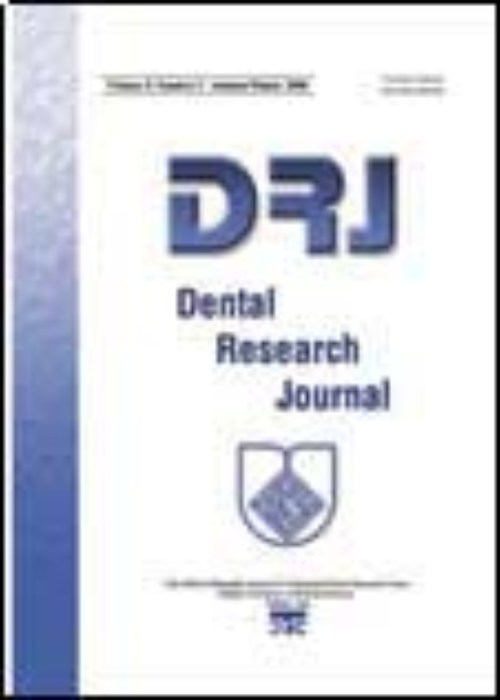Comparison of microleakage in Class II cavities restored with siloranebased and methacrylate-based composite resins using different restorative techniques over time
Author(s):
Abstract:
Background
Despite the growing tendency toward tooth-colored restorations in dentistry, polymerization shrinkage and subsequent marginal microleakage remains a problem. The aim of this in vitro study was to compare microleakage between silorane-based and methacrylate-based composite resins at different time intervals and with different restorative techniques. Materials And Methods
In this in vitro study, 108 sound extracted human molar teeth were used. Mesial and distal proximal class II boxes with dimensions of 1.5 mm depth and 4 mm width were prepared. The gingival margins of all cavities were 1 mm below the cement enamel junction. The teeth were randomly divided into three groups based on test materials. In the fi rst group, the teeth were restored by a nanocomposite (Filtek Z350XT, 3MESPE) and SE Bond adhesive (Kuraray, Japan), in the second group, the teeth were restored with a silorane-based (Filtek P90, 3MESPE) and Filtek P90 Adhesive (3M ESPE, USA) and in the third group, the teeth were restored with a microhybrid posterior composite resin (Filtek P60, 3MESPE) and SE Bond adhesive (Kuraray, Japan). Half of the proximal cavities in each of these three groups were restored in two horizontal layers and the other half in four horizontal layers. After a period of aging (24-h, 3-month and 6-month) in water and then application of 500 thermal cycles, the teeth were immersed for 24-h in 0.5% fuchsin and evaluated under a stereomicroscope at ×36 magnifi cation to evaluate leakage in gingival margin. Data was statistically analyzed using Kruskal-Wallis and Mann-Whitney U-tests. P ≤ 0.05 was considered as signifi cant.Results
In Z350XT statistically signifi cant differences were observed in microleakage in comparison of 24-h and 6-month intervals (P = 0.01) that was higher in 6-month. Comparison of microleakage in P90 and P60 composite resins was also statistically signifi cant and was less in P90. Microleakage was not signifi cantly different between P90 and Z350XT at 24-h. However, this difference was signifi cant at 3-month and 6-month intervals. Differences in microleakage of P60 and Z-350XT composite resins were not statistically signifi cant in all intervals (P = 0.38). P90 showed the lowest microleakage during storage in water. Z350XT had microleakage similar to P90 within 24-h, but after 6-month of storage in water, it showed the highest microleakage among all the groups. The number of layers (2 layers vs. 4 layers) did not result in any differences in microleakage scores of the composite resins (P = 0.42). Conclusion
Water storage times did not result in any signifi cant effect on microleakage of P90 and P60.Keywords:
Language:
English
Published:
Dental Research Journal, Volume:12 Issue: 2, Mar 2015
Page:
150
magiran.com/p1386161
دانلود و مطالعه متن این مقاله با یکی از روشهای زیر امکان پذیر است:
اشتراک شخصی
با عضویت و پرداخت آنلاین حق اشتراک یکساله به مبلغ 1,390,000ريال میتوانید 70 عنوان مطلب دانلود کنید!
اشتراک سازمانی
به کتابخانه دانشگاه یا محل کار خود پیشنهاد کنید تا اشتراک سازمانی این پایگاه را برای دسترسی نامحدود همه کاربران به متن مطالب تهیه نمایند!
توجه!
- حق عضویت دریافتی صرف حمایت از نشریات عضو و نگهداری، تکمیل و توسعه مگیران میشود.
- پرداخت حق اشتراک و دانلود مقالات اجازه بازنشر آن در سایر رسانههای چاپی و دیجیتال را به کاربر نمیدهد.
In order to view content subscription is required
Personal subscription
Subscribe magiran.com for 70 € euros via PayPal and download 70 articles during a year.
Organization subscription
Please contact us to subscribe your university or library for unlimited access!


